BUSN20017 Effective Business Communication: Emotions Analysis
VerifiedAdded on 2023/06/16
|8
|1374
|231
Report
AI Summary
This report explores the role of emotions in business communication, analyzing their potential to enhance or diminish message effectiveness. It addresses the challenges of conveying emotional nuance in lean media and examines appropriate managerial responses to emotional expressions in job applications. The report further discusses the appropriateness and extent to which emotions should be used in business contexts, emphasizing the importance of context and individual differences in determining effective communication strategies. Ultimately, it concludes that emotions are neither inherently good nor bad but require careful consideration in their application within the workplace.
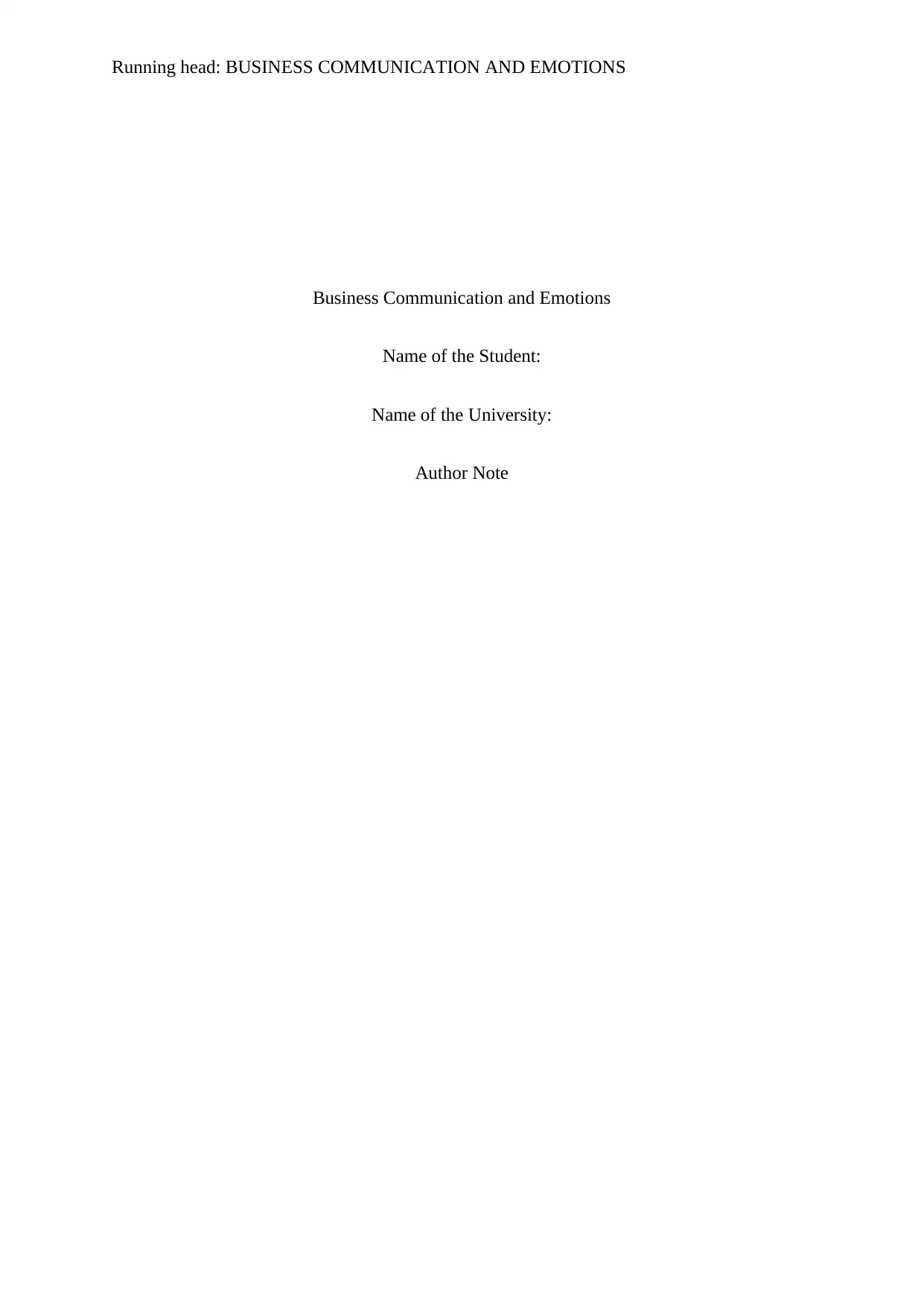
Running head: BUSINESS COMMUNICATION AND EMOTIONS
Business Communication and Emotions
Name of the Student:
Name of the University:
Author Note
Business Communication and Emotions
Name of the Student:
Name of the University:
Author Note
Paraphrase This Document
Need a fresh take? Get an instant paraphrase of this document with our AI Paraphraser
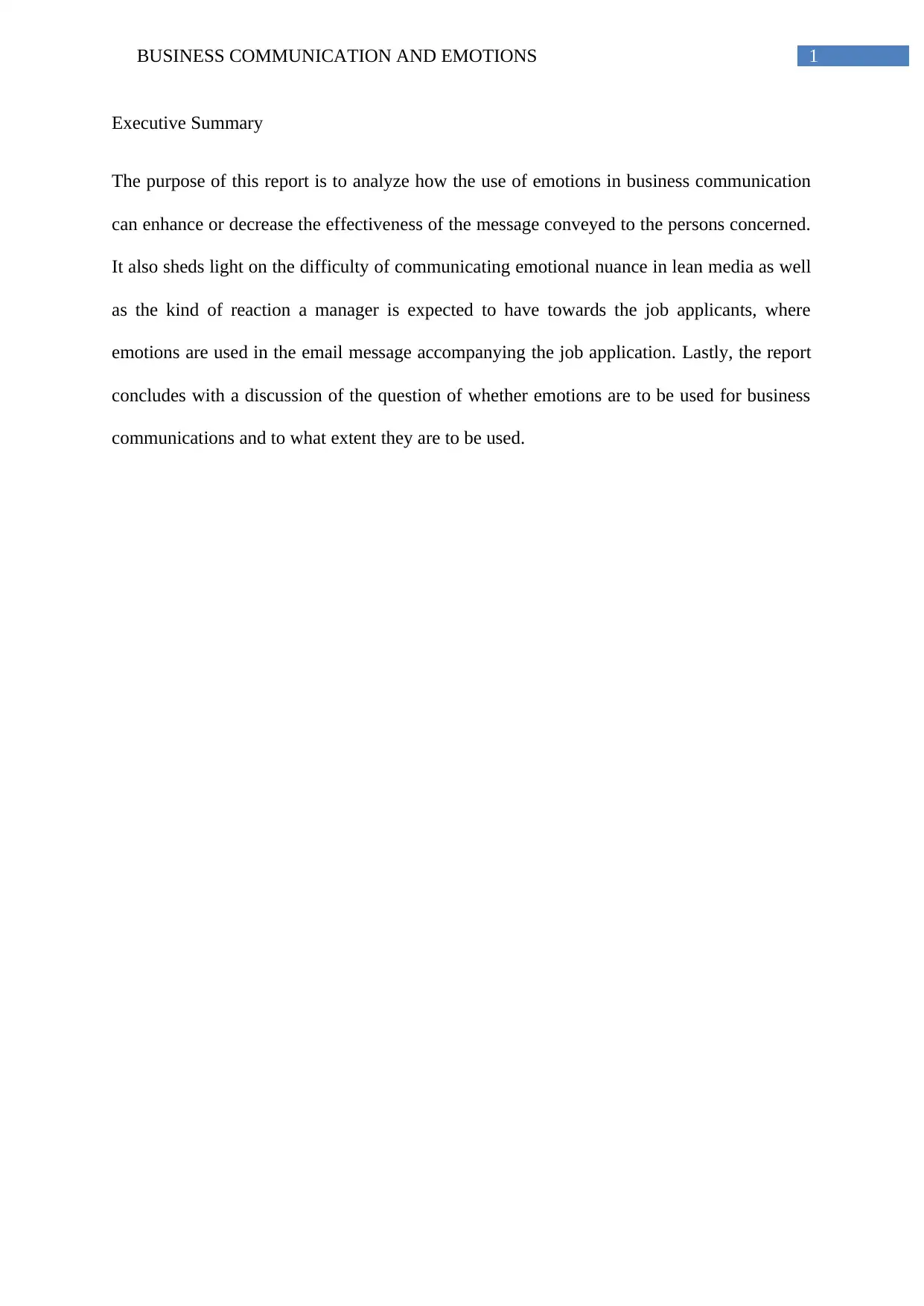
1BUSINESS COMMUNICATION AND EMOTIONS
Executive Summary
The purpose of this report is to analyze how the use of emotions in business communication
can enhance or decrease the effectiveness of the message conveyed to the persons concerned.
It also sheds light on the difficulty of communicating emotional nuance in lean media as well
as the kind of reaction a manager is expected to have towards the job applicants, where
emotions are used in the email message accompanying the job application. Lastly, the report
concludes with a discussion of the question of whether emotions are to be used for business
communications and to what extent they are to be used.
Executive Summary
The purpose of this report is to analyze how the use of emotions in business communication
can enhance or decrease the effectiveness of the message conveyed to the persons concerned.
It also sheds light on the difficulty of communicating emotional nuance in lean media as well
as the kind of reaction a manager is expected to have towards the job applicants, where
emotions are used in the email message accompanying the job application. Lastly, the report
concludes with a discussion of the question of whether emotions are to be used for business
communications and to what extent they are to be used.
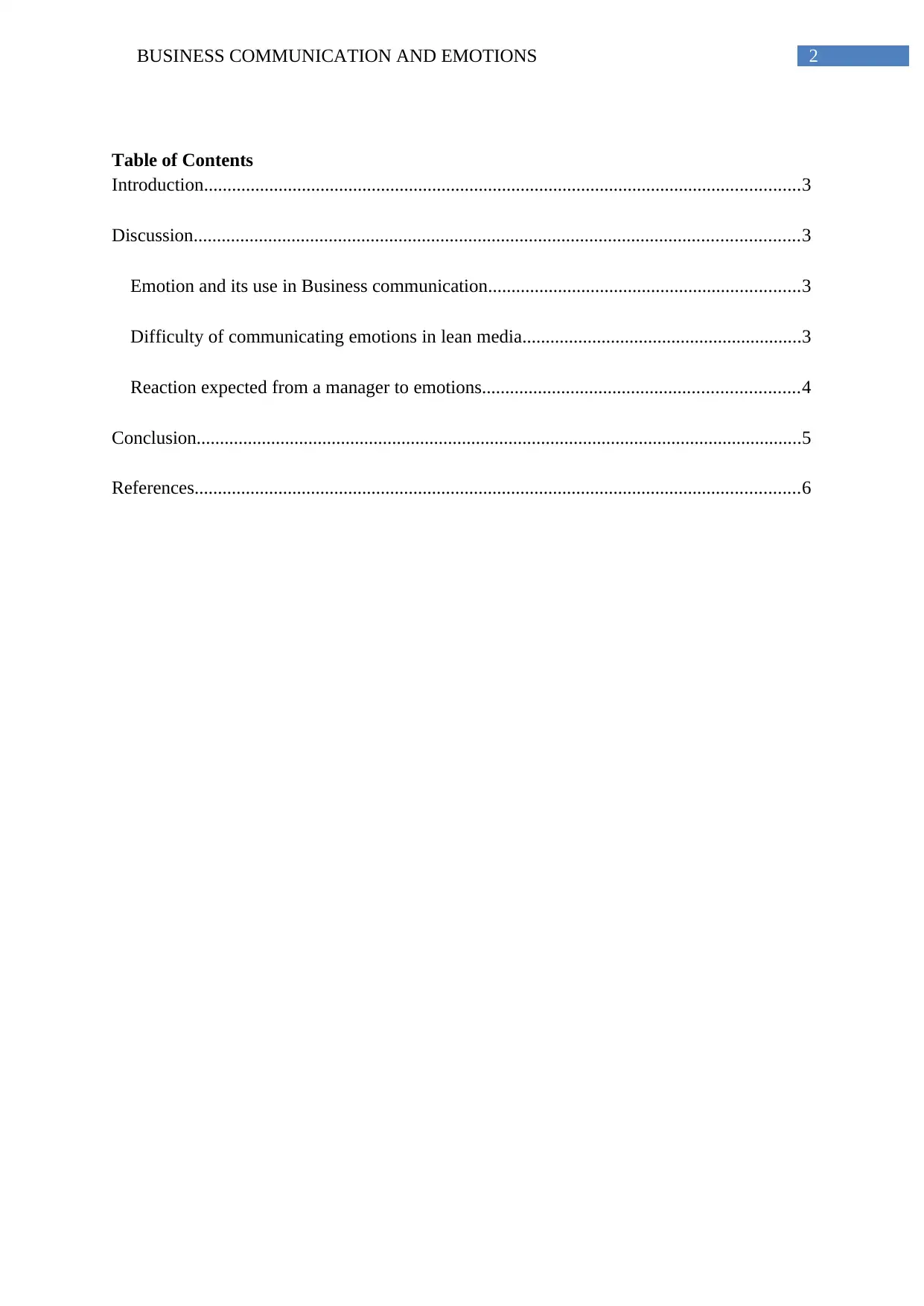
2BUSINESS COMMUNICATION AND EMOTIONS
Table of Contents
Introduction................................................................................................................................3
Discussion..................................................................................................................................3
Emotion and its use in Business communication...................................................................3
Difficulty of communicating emotions in lean media............................................................3
Reaction expected from a manager to emotions....................................................................4
Conclusion..................................................................................................................................5
References..................................................................................................................................6
Table of Contents
Introduction................................................................................................................................3
Discussion..................................................................................................................................3
Emotion and its use in Business communication...................................................................3
Difficulty of communicating emotions in lean media............................................................3
Reaction expected from a manager to emotions....................................................................4
Conclusion..................................................................................................................................5
References..................................................................................................................................6
⊘ This is a preview!⊘
Do you want full access?
Subscribe today to unlock all pages.

Trusted by 1+ million students worldwide
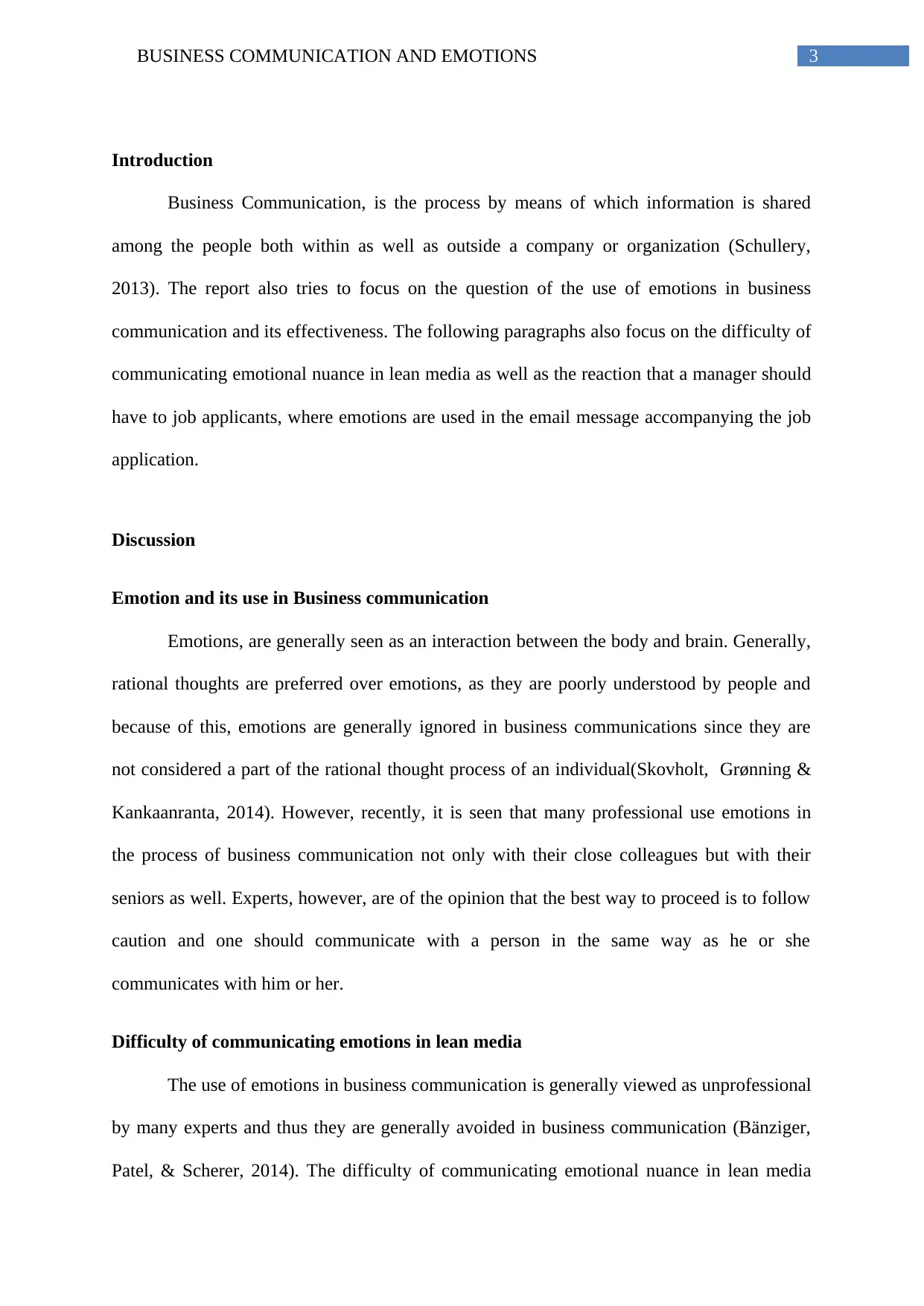
3BUSINESS COMMUNICATION AND EMOTIONS
Introduction
Business Communication, is the process by means of which information is shared
among the people both within as well as outside a company or organization (Schullery,
2013). The report also tries to focus on the question of the use of emotions in business
communication and its effectiveness. The following paragraphs also focus on the difficulty of
communicating emotional nuance in lean media as well as the reaction that a manager should
have to job applicants, where emotions are used in the email message accompanying the job
application.
Discussion
Emotion and its use in Business communication
Emotions, are generally seen as an interaction between the body and brain. Generally,
rational thoughts are preferred over emotions, as they are poorly understood by people and
because of this, emotions are generally ignored in business communications since they are
not considered a part of the rational thought process of an individual(Skovholt, Grønning &
Kankaanranta, 2014). However, recently, it is seen that many professional use emotions in
the process of business communication not only with their close colleagues but with their
seniors as well. Experts, however, are of the opinion that the best way to proceed is to follow
caution and one should communicate with a person in the same way as he or she
communicates with him or her.
Difficulty of communicating emotions in lean media
The use of emotions in business communication is generally viewed as unprofessional
by many experts and thus they are generally avoided in business communication (Bänziger,
Patel, & Scherer, 2014). The difficulty of communicating emotional nuance in lean media
Introduction
Business Communication, is the process by means of which information is shared
among the people both within as well as outside a company or organization (Schullery,
2013). The report also tries to focus on the question of the use of emotions in business
communication and its effectiveness. The following paragraphs also focus on the difficulty of
communicating emotional nuance in lean media as well as the reaction that a manager should
have to job applicants, where emotions are used in the email message accompanying the job
application.
Discussion
Emotion and its use in Business communication
Emotions, are generally seen as an interaction between the body and brain. Generally,
rational thoughts are preferred over emotions, as they are poorly understood by people and
because of this, emotions are generally ignored in business communications since they are
not considered a part of the rational thought process of an individual(Skovholt, Grønning &
Kankaanranta, 2014). However, recently, it is seen that many professional use emotions in
the process of business communication not only with their close colleagues but with their
seniors as well. Experts, however, are of the opinion that the best way to proceed is to follow
caution and one should communicate with a person in the same way as he or she
communicates with him or her.
Difficulty of communicating emotions in lean media
The use of emotions in business communication is generally viewed as unprofessional
by many experts and thus they are generally avoided in business communication (Bänziger,
Patel, & Scherer, 2014). The difficulty of communicating emotional nuance in lean media
Paraphrase This Document
Need a fresh take? Get an instant paraphrase of this document with our AI Paraphraser
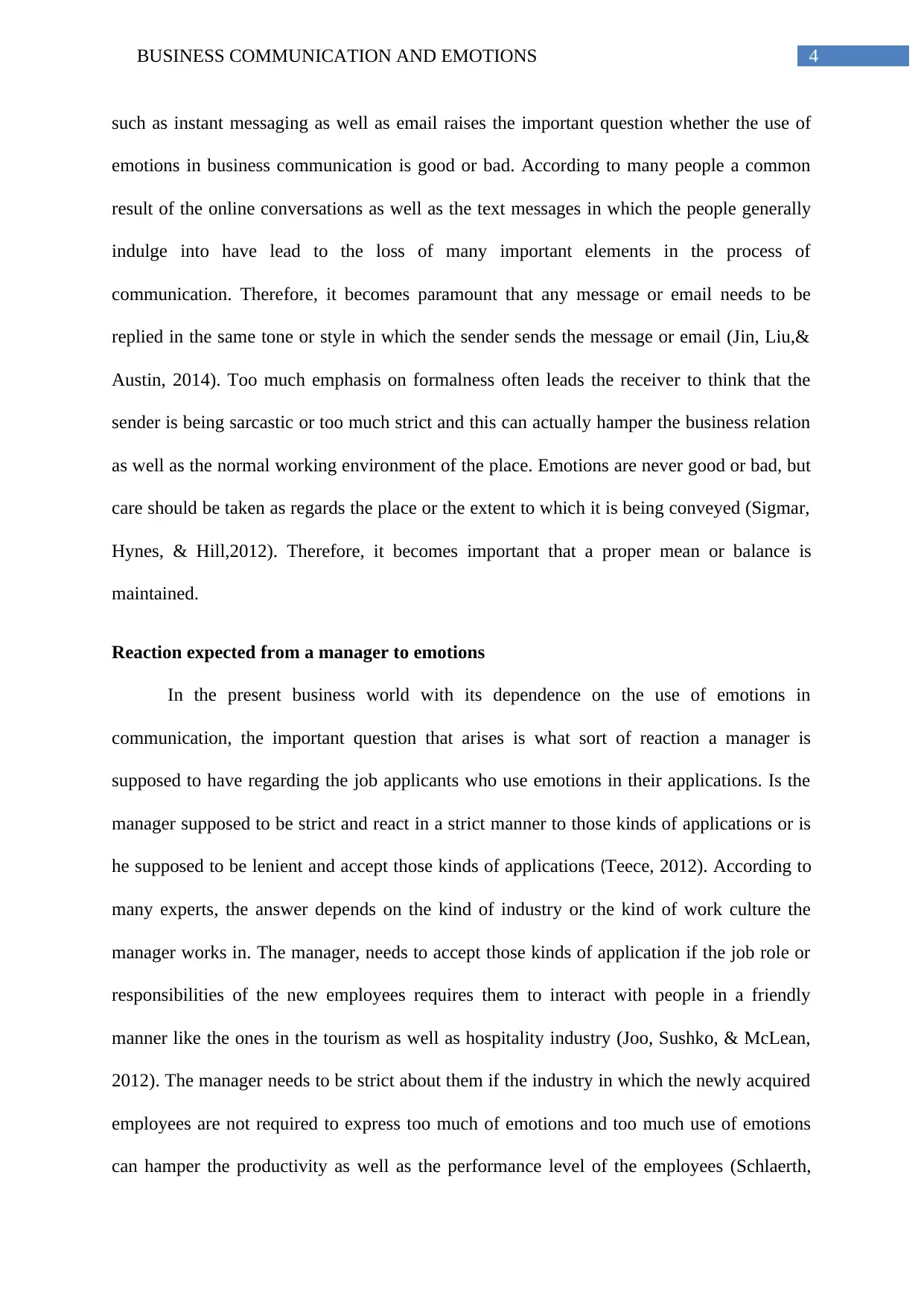
4BUSINESS COMMUNICATION AND EMOTIONS
such as instant messaging as well as email raises the important question whether the use of
emotions in business communication is good or bad. According to many people a common
result of the online conversations as well as the text messages in which the people generally
indulge into have lead to the loss of many important elements in the process of
communication. Therefore, it becomes paramount that any message or email needs to be
replied in the same tone or style in which the sender sends the message or email (Jin, Liu,&
Austin, 2014). Too much emphasis on formalness often leads the receiver to think that the
sender is being sarcastic or too much strict and this can actually hamper the business relation
as well as the normal working environment of the place. Emotions are never good or bad, but
care should be taken as regards the place or the extent to which it is being conveyed (Sigmar,
Hynes, & Hill,2012). Therefore, it becomes important that a proper mean or balance is
maintained.
Reaction expected from a manager to emotions
In the present business world with its dependence on the use of emotions in
communication, the important question that arises is what sort of reaction a manager is
supposed to have regarding the job applicants who use emotions in their applications. Is the
manager supposed to be strict and react in a strict manner to those kinds of applications or is
he supposed to be lenient and accept those kinds of applications (Teece, 2012). According to
many experts, the answer depends on the kind of industry or the kind of work culture the
manager works in. The manager, needs to accept those kinds of application if the job role or
responsibilities of the new employees requires them to interact with people in a friendly
manner like the ones in the tourism as well as hospitality industry (Joo, Sushko, & McLean,
2012). The manager needs to be strict about them if the industry in which the newly acquired
employees are not required to express too much of emotions and too much use of emotions
can hamper the productivity as well as the performance level of the employees (Schlaerth,
such as instant messaging as well as email raises the important question whether the use of
emotions in business communication is good or bad. According to many people a common
result of the online conversations as well as the text messages in which the people generally
indulge into have lead to the loss of many important elements in the process of
communication. Therefore, it becomes paramount that any message or email needs to be
replied in the same tone or style in which the sender sends the message or email (Jin, Liu,&
Austin, 2014). Too much emphasis on formalness often leads the receiver to think that the
sender is being sarcastic or too much strict and this can actually hamper the business relation
as well as the normal working environment of the place. Emotions are never good or bad, but
care should be taken as regards the place or the extent to which it is being conveyed (Sigmar,
Hynes, & Hill,2012). Therefore, it becomes important that a proper mean or balance is
maintained.
Reaction expected from a manager to emotions
In the present business world with its dependence on the use of emotions in
communication, the important question that arises is what sort of reaction a manager is
supposed to have regarding the job applicants who use emotions in their applications. Is the
manager supposed to be strict and react in a strict manner to those kinds of applications or is
he supposed to be lenient and accept those kinds of applications (Teece, 2012). According to
many experts, the answer depends on the kind of industry or the kind of work culture the
manager works in. The manager, needs to accept those kinds of application if the job role or
responsibilities of the new employees requires them to interact with people in a friendly
manner like the ones in the tourism as well as hospitality industry (Joo, Sushko, & McLean,
2012). The manager needs to be strict about them if the industry in which the newly acquired
employees are not required to express too much of emotions and too much use of emotions
can hamper the productivity as well as the performance level of the employees (Schlaerth,
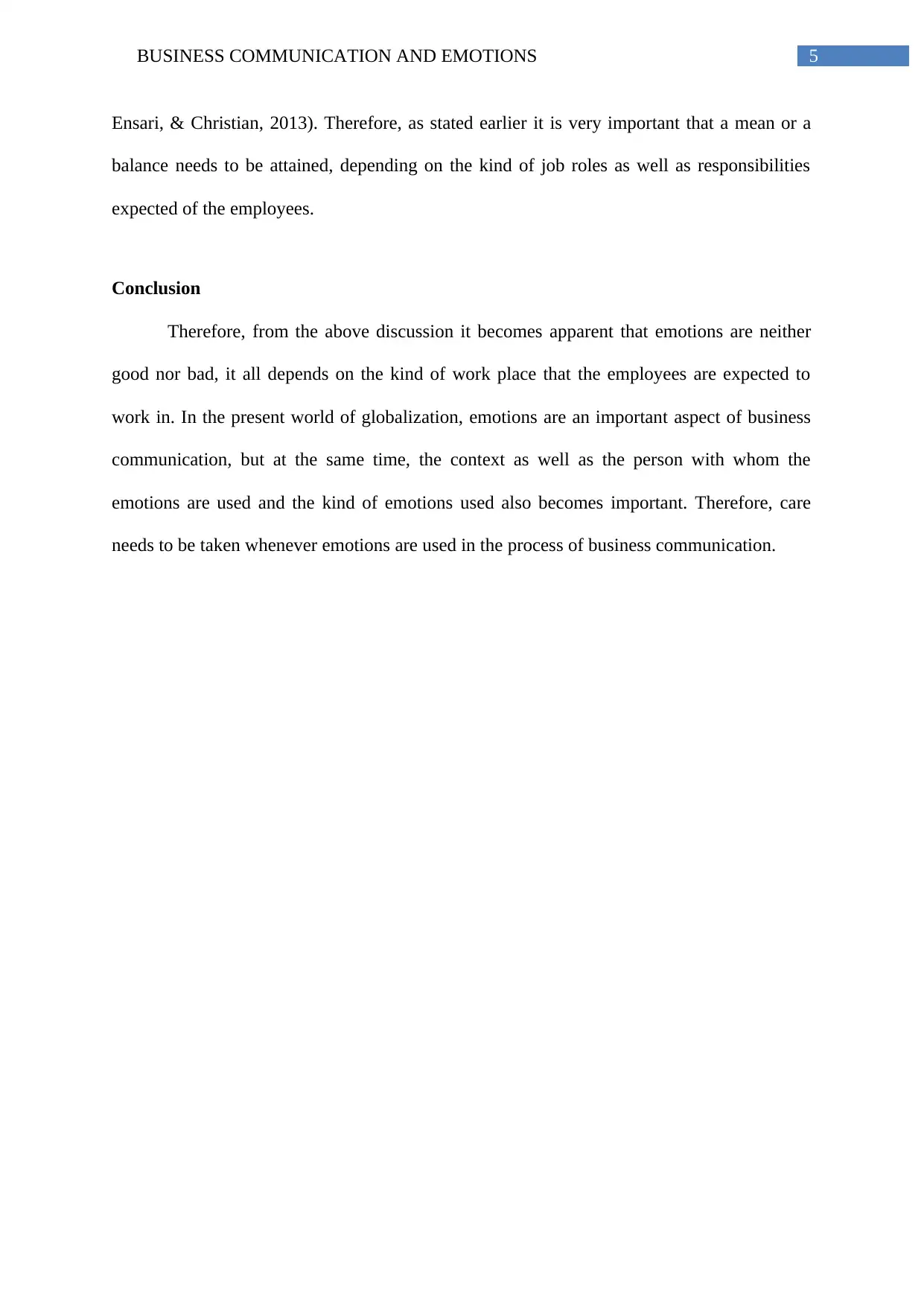
5BUSINESS COMMUNICATION AND EMOTIONS
Ensari, & Christian, 2013). Therefore, as stated earlier it is very important that a mean or a
balance needs to be attained, depending on the kind of job roles as well as responsibilities
expected of the employees.
Conclusion
Therefore, from the above discussion it becomes apparent that emotions are neither
good nor bad, it all depends on the kind of work place that the employees are expected to
work in. In the present world of globalization, emotions are an important aspect of business
communication, but at the same time, the context as well as the person with whom the
emotions are used and the kind of emotions used also becomes important. Therefore, care
needs to be taken whenever emotions are used in the process of business communication.
Ensari, & Christian, 2013). Therefore, as stated earlier it is very important that a mean or a
balance needs to be attained, depending on the kind of job roles as well as responsibilities
expected of the employees.
Conclusion
Therefore, from the above discussion it becomes apparent that emotions are neither
good nor bad, it all depends on the kind of work place that the employees are expected to
work in. In the present world of globalization, emotions are an important aspect of business
communication, but at the same time, the context as well as the person with whom the
emotions are used and the kind of emotions used also becomes important. Therefore, care
needs to be taken whenever emotions are used in the process of business communication.
⊘ This is a preview!⊘
Do you want full access?
Subscribe today to unlock all pages.

Trusted by 1+ million students worldwide
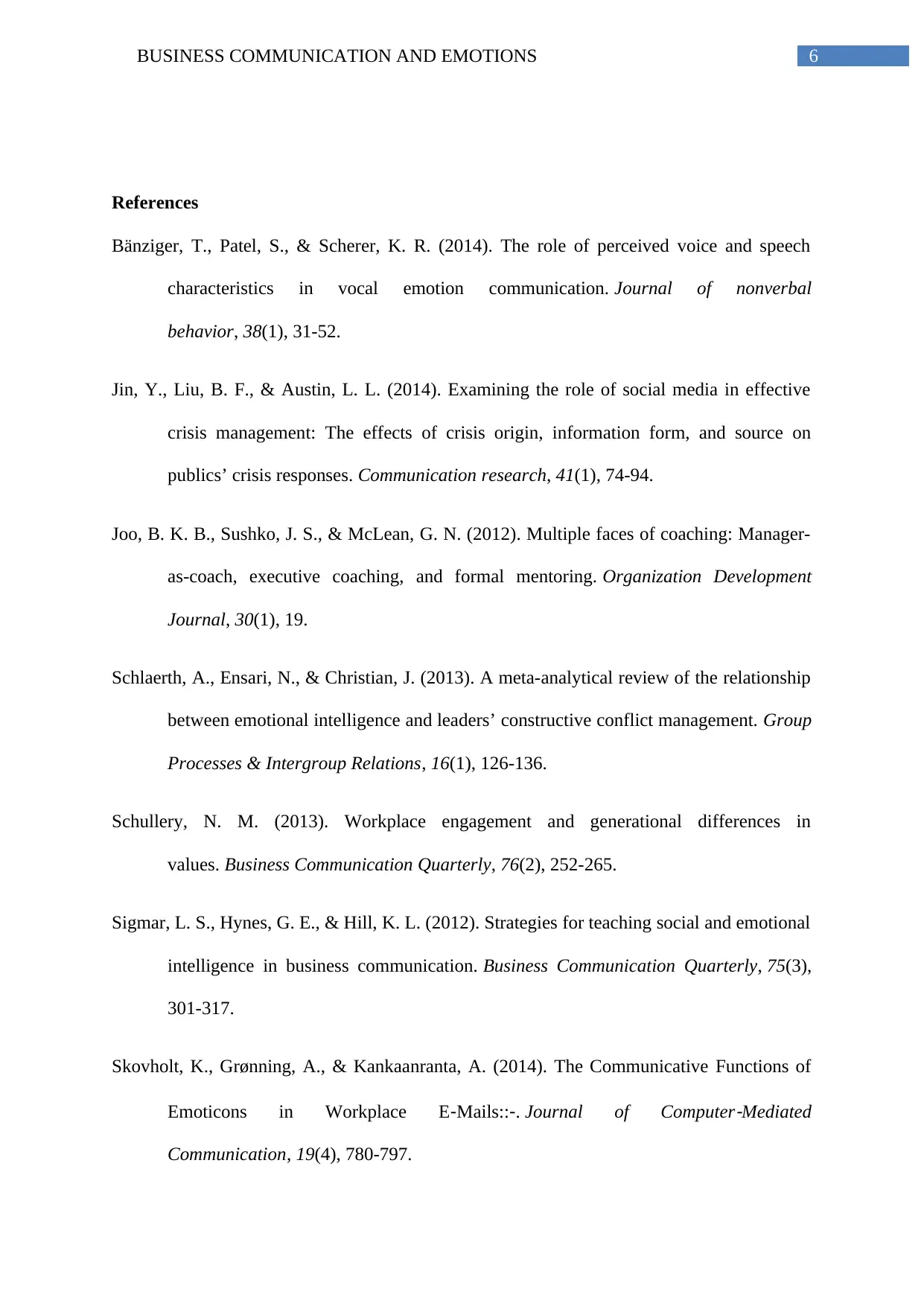
6BUSINESS COMMUNICATION AND EMOTIONS
References
Bänziger, T., Patel, S., & Scherer, K. R. (2014). The role of perceived voice and speech
characteristics in vocal emotion communication. Journal of nonverbal
behavior, 38(1), 31-52.
Jin, Y., Liu, B. F., & Austin, L. L. (2014). Examining the role of social media in effective
crisis management: The effects of crisis origin, information form, and source on
publics’ crisis responses. Communication research, 41(1), 74-94.
Joo, B. K. B., Sushko, J. S., & McLean, G. N. (2012). Multiple faces of coaching: Manager-
as-coach, executive coaching, and formal mentoring. Organization Development
Journal, 30(1), 19.
Schlaerth, A., Ensari, N., & Christian, J. (2013). A meta-analytical review of the relationship
between emotional intelligence and leaders’ constructive conflict management. Group
Processes & Intergroup Relations, 16(1), 126-136.
Schullery, N. M. (2013). Workplace engagement and generational differences in
values. Business Communication Quarterly, 76(2), 252-265.
Sigmar, L. S., Hynes, G. E., & Hill, K. L. (2012). Strategies for teaching social and emotional
intelligence in business communication. Business Communication Quarterly, 75(3),
301-317.
Skovholt, K., Grønning, A., & Kankaanranta, A. (2014). The Communicative Functions of
Emoticons in Workplace E‐Mails::‐. Journal of Computer
‐Mediated
Communication, 19(4), 780-797.
References
Bänziger, T., Patel, S., & Scherer, K. R. (2014). The role of perceived voice and speech
characteristics in vocal emotion communication. Journal of nonverbal
behavior, 38(1), 31-52.
Jin, Y., Liu, B. F., & Austin, L. L. (2014). Examining the role of social media in effective
crisis management: The effects of crisis origin, information form, and source on
publics’ crisis responses. Communication research, 41(1), 74-94.
Joo, B. K. B., Sushko, J. S., & McLean, G. N. (2012). Multiple faces of coaching: Manager-
as-coach, executive coaching, and formal mentoring. Organization Development
Journal, 30(1), 19.
Schlaerth, A., Ensari, N., & Christian, J. (2013). A meta-analytical review of the relationship
between emotional intelligence and leaders’ constructive conflict management. Group
Processes & Intergroup Relations, 16(1), 126-136.
Schullery, N. M. (2013). Workplace engagement and generational differences in
values. Business Communication Quarterly, 76(2), 252-265.
Sigmar, L. S., Hynes, G. E., & Hill, K. L. (2012). Strategies for teaching social and emotional
intelligence in business communication. Business Communication Quarterly, 75(3),
301-317.
Skovholt, K., Grønning, A., & Kankaanranta, A. (2014). The Communicative Functions of
Emoticons in Workplace E‐Mails::‐. Journal of Computer
‐Mediated
Communication, 19(4), 780-797.
Paraphrase This Document
Need a fresh take? Get an instant paraphrase of this document with our AI Paraphraser
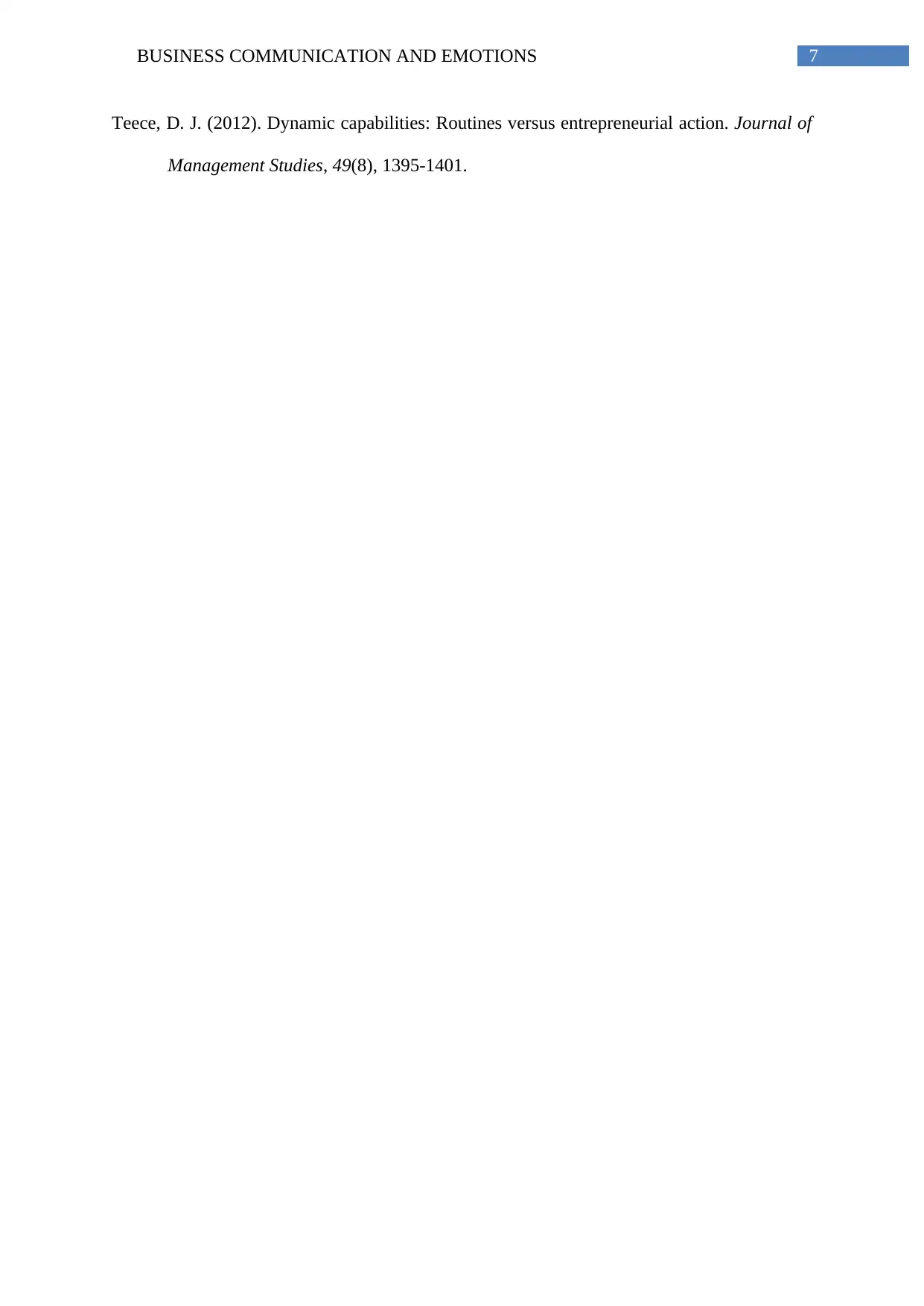
7BUSINESS COMMUNICATION AND EMOTIONS
Teece, D. J. (2012). Dynamic capabilities: Routines versus entrepreneurial action. Journal of
Management Studies, 49(8), 1395-1401.
Teece, D. J. (2012). Dynamic capabilities: Routines versus entrepreneurial action. Journal of
Management Studies, 49(8), 1395-1401.
1 out of 8
Related Documents
Your All-in-One AI-Powered Toolkit for Academic Success.
+13062052269
info@desklib.com
Available 24*7 on WhatsApp / Email
![[object Object]](/_next/static/media/star-bottom.7253800d.svg)
Unlock your academic potential
Copyright © 2020–2025 A2Z Services. All Rights Reserved. Developed and managed by ZUCOL.

